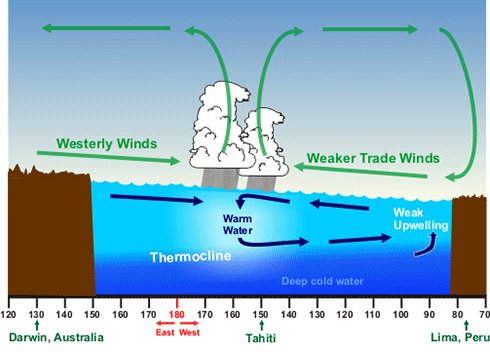
|
Published: 25 November 2013
Warming doubles odds of abnormal El Nino
Unusual El Ninos, like those that led to the extraordinary ‘super El Nino’ years of 1982 and 1997, will occur twice as often under even modest global warming scenarios, according to a new analysis published in Nature.

|
|
Under normal El Ninos, ocean surface temperatures first warm in the cold eastern Pacific and then expand west, in the direction of the trade winds and ocean currents along the equator. Credit:
NOAA
|
The team who carried out the analysis included Australian scientists from the ARC Centre of Excellence for Climate Systems Science and CSIRO.
Super El Ninos differ from the more common kind in that sea surface temperatures start warming in the west of the Pacific Basin and spread eastwards. Under normal El Ninos, ocean surface temperatures first warm in the cold eastern Pacific and then expand west, in the direction of the trade winds and ocean currents along the equator.
‘These unusual El Ninos appeared for the first time in the available record sometime after the mid 1970s,’ said lead author, Dr Agus Santoso from the ARC Centre of Excellence for Climate Systems Science.
Scientists have struggled to explain why they occurred and if the frequency would change in the future.
‘The most common theory used to explain these unusual El Ninos was that competing air and ocean feedbacks drove the direction of the warming,’ Dr Santoso said.
‘But if this was true, La Ninas would have propagated in the same direction. Observations show they do not.’
The researchers found the key to the mystery was the weakening of westward-flowing currents along the Equator in the Pacific Ocean. As these currents weakened and even reversed, it allowed the heat during these unusual El Nino events to spread more easily into the eastern Pacific.
La Nina events didn’t behave in a similar way, because the currents are strong and flow to the west.
Importantly, using observations and climate models, the researchers were able to determine what this could mean for the future frequency of these unusual El Ninos.
‘Using observations we demonstrated the likely role of the weaker currents in the unusual behaviour,’ Dr Santoso said.
‘These currents are well represented in a number of climate models. Using these models we confirmed, even under modest global warming scenarios, these unusual El Nino events doubled in frequency. ‘
The 1982 and 1997 events led to highly unusual weather events worldwide, causing disruption in fisheries and agriculture that cost tens of billions of dollars and lead to the deaths of tens of thousands of people. During the 1982 event, in the US alone, crop losses were estimated at $10-12 billion (the equivalent of $24-26 billion in current terms).
‘While more frequent eastward propagating El Ninos will be a symptom of a warming planet, further research is underway to determine the impact of such events in a climate that is going to be significantly warmer than today,’ concluded co-author, Dr Wenju Cai from CSIRO.
Source: ARC CoE for Climate System Science



